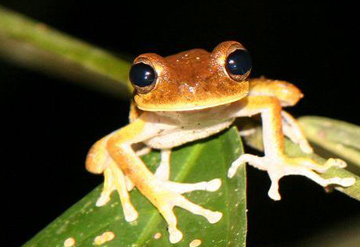New research refutes global warming’s influence on amphibians’ worst enemy
New research refutes global warming’s influence on amphibians’ worst enemy
Morgan Erickson-Davis, mongabay.com
January 30, 2008
|
|
There is no doubt that global warming is having a negative effect on amphibians, but it is yet unclear whether or not a direct causal relationship exists between global warming and the spread of a specific fungal epidemic wreaking havoc on amphibian populations worldwide.
In 1998 a previously undescribed pathogenic fungus, Batrachochytrium dendrobatidis, belonging to the chytrid group of fungi, was reported independently in Panama and northern Queensland, Australia, where it was causing massive declines in local frog populations. Since then, it has become the dominant cause of amphibian declines and extinctions worldwide.
Research has been undertaken in effort to determine whether global warming is encouraging the disease to spread so quickly, or if instead, human global movements are mainly to blame. A study authored by a team headed by J. Alan Pounds in 2006 and published in the journal Nature reported that most fungal pathogen-linked extinctions of harlequin frogs in upland rainforests of South America occurred immediately after years during which those areas experienced higher than average temperatures, implicating global warming.
 Tree frog in Peru. |
However, new findings are challenging those views. Investigating tropical upland rainforest tracts where amphibian declines were known to be occurring in Queensland, Dr. William Laurance of the Smithsonian Tropical Research Institute and colleagues found little direct support for the conclusions of Pounds et al, suggesting instead that at least three consecutive warmer-than-average years are necessary for there to be a significant increase in pathogen-linked declines.
Other studies have shown even less association between global warming and the spread of the chytrid fungus. In Panama and Costa Rica, fungus-linked declines were found to be spreading in a wave-like pattern typical of highly virulent epidemics and unaffected by weather variables. Other studies performed in eastern Australian rainforests also show wave-like patterns of spread.
The chytrid fungal pathogen is currently found in 93 species of amphibians worldwide, with Australian frogs the most affected. Forty-eight native Australian species – or 22 percent of its frogs – are currently affected by the disease, resulting in fifteen species listed as endangered and four having become extinct since 1980. The Gastic Brooding Frog (Rheobatrachus silus) is an example of these, killed off in the mid-1980s before the fungus was even identified. The chytrid fungus affects the skin and is mainly aquatic. While not able to enter eggs, it can be present in and around the mouthparts of tadpoles, infecting them completely once metamorphosis occurs.
Other causes of the global decline of amphibian populations include habitat destruction and modification, pollution, pesticide-use, climate change, increased UV-B radiation, and additional diseases. The Global Amphibian Assessment reports that nearly one third of all species (32%) are threatened, with 42% having declined since the 1980s. As many as 165 species are thought to have become extinct during the past thirty years. Calculations comparing current extinction rates of amphibians to background, or normal, extinction rates have yielded a current rate that is 211 times larger than background rates. When endangered species are included in the calculation, the result is expanded to 25,039—45,474 times that of background extinction rates.
Amphibian declines have grown so severe that in February 16th, 2007, scientists from all over the world met in Atlanta, GA, to form the Amphibian Ark, a group dedicated to the preservation of more than 6,000 species of frogs, toads, salamanders, and caecilians (a group of subterrestrial wormlike amphibians). Their aim is mainly concerned with implementing captive breeding programs to safeguard the most threatened species.
Along with providing a vital loss to biodiversity, amphibian declines foreshadow problems that other organisms may experience in the future. Amphibians are an important “index” group; the health of individual species serves as a powerful indicator of the health of an entire ecosystem. Scientists believe that what is happening to amphibians now will someday happen to other organisms, including humans.
Ongoing research is being conducted by scientists worldwide in effort to gain a better understanding of why amphibian populations are declining and in order to determine possible solutions. The chytrid fungal pathogen remains one of the least understood – and most serious – causes of the declines.